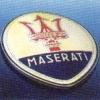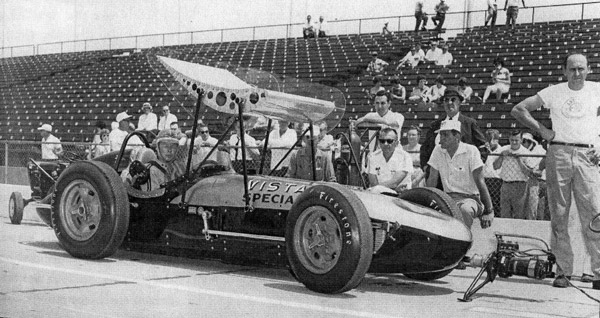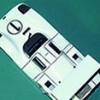http://www.racingspo...d&wi=&mode=Null

High wings on racing cars, the beginning
#1

Posted 07 December 2015 - 02:19
#3

Posted 07 December 2015 - 02:25
McLaren Mini van, please.
#4

Posted 07 December 2015 - 02:25
But that also included low and body-mounted wings. Brabham at Spa in 1967 was the first in F1 if I recall, but there was also the May brothers with a high-mounted aerofoil at the Targa Florio (or was it the Nurburgring?) in 1955 with their Porsche.
#5

Posted 07 December 2015 - 02:26
As has been noted previously on these Forums, a Porsche Spyder featured a high mounted wing many years before our man Jim did.
#6

Posted 07 December 2015 - 02:47
Brabham at Spa in 1967 was the first in F1 if I recall...
Whenever F1 people worked it out, nobody noticed or mentioned it. So Brabham used flaps, and BRM bought in aerodynamic research for years. Others had to build a sports car that stuck to the ground too much for F1 designers to change minds.
#7

Posted 07 December 2015 - 02:50
I did search to see if the subject had been raised before, and I am not surprised that Hall was not the first one with the idea. Very few things in motor sport are new.
The Chaparral 2E was the 1966 Can Am car, and according to Jim Hall his first high wing model. The team did not make the Can Am opener at St Jovite, but were at the 2nd race Bridgehampton. I saw the car at the 3rd round, Mosport, and was astonished when it went by in the parade lap. I simply did not like the aesthetics, especially as the previous models were so good looking. Still the idea must have worked, since he had so many copiers. The car was not very successful according to Hall's previous standards, winning just once with Phil Hill at Laguna Seca..

Edited by Vitesse2, 07 December 2015 - 09:50.
#8

Posted 07 December 2015 - 04:09
There has been a photo posted previously of the May brothers' car with its high wing. If I recall correctly, it was over the cockpit area.
1955 also saw Mercedes-Benz fiddling with aerodynamic devices on their sports cars, having what they called 'air brakes' on them.
#9

Posted 07 December 2015 - 04:34
First F1 car to use wings?
which, as its title suggests, mainly relates to F1, but does mention the May brothers' Porsche and the Chaparrals, and also the use of wings on US Sprint cars as early as 1958.
Edited by Tim Murray, 07 December 2015 - 04:38.
#10

Posted 07 December 2015 - 04:48
There are a few internet references to the May brothers' Porsche including this;
http://simanaitissay...marvelous-idea/
#11

Posted 07 December 2015 - 05:17
There are a few internet references to the May brothers' Porsche including this;
It would appear this fellow read May's writings.
Indianapolis 1962.

From this site, which while not directly related to the topic is interesting.
http://www.coastal18...ay_photos-C.htm
#12

Posted 07 December 2015 - 06:55
From this site, which while not directly related to the topic is interesting.
http://www.coastal18...ay_photos-C.htm
Thanks Bob - there's some amazing stuff in there.
#13

Posted 07 December 2015 - 08:12
In 1924 there was a great deal of debate about how light, powerful and therefore dangerous racing cars had become. The Autocar published a letter with a suggestion for improving road adhesion:
"Would it not be practicable to fit light racing cars for track use with a couple of ailerons one projecting each side of the car about the back of the driver's seat and at the level of the chassis frame ... the adjustment could be partly by hand interconnected with a pointer and scale in view of the driver so that settings found suitable ... could quickly be made with certainty.
"Has any reader tried devices on the lines indicated?"
William Court reported this in Power and Glory and commented:
"Well if any of The Autocar's readers HAD, they certainly were not owning up to it in print and to this day no racing car has been fitted with ailerons."
#14

Posted 07 December 2015 - 08:26
I think it was a Benz.
#15

Posted 07 December 2015 - 08:56
There was a car in that era did have them...
I think it was a Benz.
An Opel, i think.
#16

Posted 07 December 2015 - 09:06
http://www.mad4wheel...ar_001_0938.jpg
More info on this page:
http://www.droopsnoot.co.uk/rak2.htm
where it's suggested that Michael May was inspired by these cars to fit the wing to his Porsche in 1956.
Edited by Tim Murray, 07 December 2015 - 09:09.
#17

Posted 07 December 2015 - 09:21
And rocket powered, I'd forgotten that part.
#18

Posted 07 December 2015 - 11:33
The Mercedes T80 also had stabilising fins too, didn't it?, somewhat in the fashion of the Opel - although more elegantly integrated into the bodywork. Does anyone know if the fins on the T80 were actually of a wing profile?
Another point aspect to the Porsche is that the May clearly understood the value of the wing being raised up into 'cleaner' air - and, importantly, that wing was adjustable by some pivot-cable-lever mechanism.
It's never been clear to what extent Hall and Sharp might have been aware of the Porsche - but it does appear that they arrived at their devices empirically through the problems and analysis of their own cars. But there is evidence that true wing shapes had been used elsewhere - eg the pic linked by Bob Riebe above and also in drag racing.
A Forix article which includes a discourse on the May Porsche suggests that it was at least ten years before the idea was picked up and run with elsewhere - a minor point, but in fact the Chaparral 2C, with driver adjustable flap on the tail appeared in 1965 (and later, briefly, on the 2D). What that article does highlight - and I had been wholly unaware of - is that Michael May was an engineer at Ferrari when the amidships wing appeared on their F1 contender in '68 and it's suggested there that the device was used initially for stability on quicker circuits rather than chiefly for generating downforce.
The important points about the wing on the 2E (aside from the pedal-activated adjustability, made practical by the lack of a clutch pedal) were its unsprung mounting (on the uprights, putting the download where it belongs) and its balancing by the adjustable flap in the nose.
Another plus point for the May Porsche (and perhaps that Vista Special too) is that it makes the Laguna Seca iteration of the Chaparral 2H look a little more elegant...
Edited by 2F-001, 07 December 2015 - 12:06.
#19

Posted 07 December 2015 - 12:43
Advertisement
#20

Posted 07 December 2015 - 13:55
This device from 1953 is intriguing:
Autosport described it as a 'fog-box', intended to defeat glare in conditions of fog or driving snow.
#21

Posted 07 December 2015 - 17:39
Driven by Maurice Gatsonides. Another of his inventions?
#22

Posted 07 December 2015 - 17:56
From what I recall, it was a flap that was put in fron and over the additional lamps to protecht them against damage and snow and served no aero purpose at all.
Henri
#24

Posted 08 December 2015 - 01:14
current photo of winged Porsche 8th photo down in this link http://www.sportscar...t-and-photos/3/ sports car digest photos
Mike (group7) in Canada
Edited by group7, 08 December 2015 - 01:17.
#25

Posted 08 December 2015 - 10:04
The negative camber on that Porsche looks even more extreme than a boy-racer Triumph Spitfire's ![]() . Bet that wing made the steering quite light, too (if the struts were strong enough for it to have any effect)..
. Bet that wing made the steering quite light, too (if the struts were strong enough for it to have any effect)..
#26

Posted 08 December 2015 - 10:45
The negative camber on that Porsche looks even more extreme than a boy-racer Triumph Spitfire's
. Bet that wing made the steering quite light, too (if the struts were strong enough for it to have any effect)..
I don't think I've seen in-period pictures of the May Porsche carrying anything like that much negative camber at the rear.
The wing was mounted immediately ahead of the doors, so I don't see that it would cause any significant lightening of the steering.
Pictures from the time show that the uprights looked quite substantial - much more so than some of those used on Grand Prix cars (although many models of the car seem to have it fitted with quite spindly uprights mounted in a variety of locations). The uprights had a streamlined 'blade' cross-section and looked, to me, rather dangerously close to the driver's head.
I can't, for the moment, find all the details of the '56 race at the 'Ring (from which it was barred), but Forix tells us it was quick enough to post 4th best time in practice - overall or in class, I'm not sure - but ahead of numerous works cars and some big-name GP drivers. Von Hanstein sought to have it banned on the grounds of safety, although I've read no accounts suggesting it actually looked unsafe out on track or that there was any problem with the supports.
In that rear-view Pebble Beach pic, I get the feeling that the wing uprights are mounted a little further inboard than original - but it's hard to be sure. I know little else about the car and have no idea how original or authentic it is - any comments from the Porsche experts?
Does anyone know where else, other than the 'Ring, that the car may have been run in period? The familiar in-period pictures of it show it sporting variously the race numbers 34 and 37.
Edited by 2F-001, 08 December 2015 - 10:49.
#27

Posted 08 December 2015 - 11:00
Another interesting aspect of the May Porsche is the use of wing end-plates.
Chaparral fitted them to the 2Es for the last four races of '66, but I don't think anyone used them on a Grand Prix car until sometime after the '69 Monaco ruling (when the application and effectiveness of wings changed forever).
There were some pretty weird-looking devices in other formulae (e.g. multi-plane contraptions on F2 cars that, of necessity, used endplates) but not on Grand Prix cars. Were they missing a trick, or have I overlooked an obvious example?
Edited by 2F-001, 08 December 2015 - 11:33.
#28

Posted 08 December 2015 - 11:39
#29

Posted 08 December 2015 - 11:51
I should have known I was tempting fate by asking that!
The first book I turned to (Maurice Rowe's absorbing Track Record) turned up a pic of Amon and Hulme together at Rouen, both with small endplates - a picture I must have seen before. I'd forgotten all about the Brabham - and I don't think I was ever aware of that 'anomaly' on the Stewart Matra.
Thanks Tim. I must try harder...
Edited by 2F-001, 08 December 2015 - 11:52.
#30

Posted 08 December 2015 - 11:59
It seems curious that Lotus persisted in just making the wings wider and wider (notably at Montjuich Park), rather than trying to manage the airflow they already had. And unlike other teams, didn't seem to seek to reinforce the uprights.
I wonder where we'd have ended up were it not for the spate of spectacular failures.
Edited by 2F-001, 08 December 2015 - 12:04.
#31

Posted 08 December 2015 - 13:46
I can't, for the moment, find all the details of the '56 race at the 'Ring (from which it was barred), but Forix tells us it was quick enough to post 4th best time in practice - overall or in class, I'm not sure - but ahead of numerous works cars and some big-name GP drivers. Von Hanstein sought to have it banned on the grounds of safety, although I've read no accounts suggesting it actually looked unsafe out on track or that there was any problem with the supports.
In that rear-view Pebble Beach pic, I get the feeling that the wing uprights are mounted a little further inboard than original - but it's hard to be sure. I know little else about the car and have no idea how original or authentic it is - any comments from the Porsche experts?
Does anyone know where else, other than the 'Ring, that the car may have been run in period? The familiar in-period pictures of it show it sporting variously the race numbers 34 and 37.
The May brothers' Porsche was entered for the Supercortemaggiore race as well as the Nurburgring 1000kms. The Monza authorities did not allow it to practice. DSJ said that the German scrutineers passed the car but it was turned down by non-technical members of the race organisation on th grounds of danger to other competitors and the public. He didn't mention von Hanstein, nor the cars performance in practice.
Karl Ludvigsen, in Excellence Was Expected says:
"On the Friday before the race, in teeming rain, Michael May pulled out of the pits behind Fangio's Ferrari and Behra's Maserati, intending to follow them to see which way the track went for this was his first time ay the Nurburgring. To his amazement he found himself easily passing these aces in the corners! May recalls that he recorded fourth fastest practice time that day, just behind the most potent Italian sports cars and well ahead of all the 1500cc cars, including the 550A Porsches."
Later he says that the Mays had a visit from the sports director of the ADAC, Paul von Guillaume, accompanied by Huschke von Hanstein.
"They expressed concern over the manner in which the wing blocked the forward view of other drivers and said, in essence: 'We would rather you didn't race the car with this device'."
#32

Posted 08 December 2015 - 14:11
Ah, thank you Roger (I don't have the Ludvigsen book).
Now that you've said 'Monza', I realise that the pattern of the paddock paving seen in some pictures should have been a clue!
Just to continue on the finer points of wing end-plates for a moment... I was wrong to say that the 2Es used them in their last four races of '66: it appears they didn't fit them at Riverside (after Laguna Seca) but then refitted them for Las Vegas and Nassau.
And what I forgot to add in my earlier post about F1s, Chaparral didn't use them either on the 2F or 2G, so they clearly weren't considered to be an unequivocal improvement at the time.
Edited by 2F-001, 08 December 2015 - 14:11.
#33

Posted 08 December 2015 - 14:14
In earlier posts in this thread and at other times, it's always puzzled me that anyone would refer to one-on-each-side aero devices on a car as "ailerons". Ailerons on a plane, one on each wing, move in opposite directions to impart a rolling motion, and this would be entirely inappropriate on a car where their only purpose would be to stabilise or impart downforce, no similarity at all to an aileron, and of course on aircraft these are small movable sections on the trailing edge of a wing, not the entire wing. I recall that years ago, Peugeot added a small spoiler or aerofoil to the bootlid of one of their Euro-boxes, probably just as a styling feature, but puzzlingly they referred to this in their adverts as "an aileron". Clearly not many aerodynamicists in the advertising business, or probably 1980s car design for that matter.
#34

Posted 08 December 2015 - 15:18
In earlier posts in this thread and at other times, it's always puzzled me that anyone would refer to one-on-each-side aero devices on a car as "ailerons". Ailerons on a plane, one on each wing, move in opposite directions to impart a rolling motion, and this would be entirely inappropriate on a car where their only purpose would be to stabilise or impart downforce, no similarity at all to an aileron, and of course on aircraft these are small movable sections on the trailing edge of a wing, not the entire wing. I recall that years ago, Peugeot added a small spoiler or aerofoil to the bootlid of one of their Euro-boxes, probably just as a styling feature, but puzzlingly they referred to this in their adverts as "an aileron". Clearly not many aerodynamicists in the advertising business, or probably 1980s car design for that matter.
This is probably because in French the word "aileron" is not necessarily restricted to the narrow definition that you consider to be correct.

















